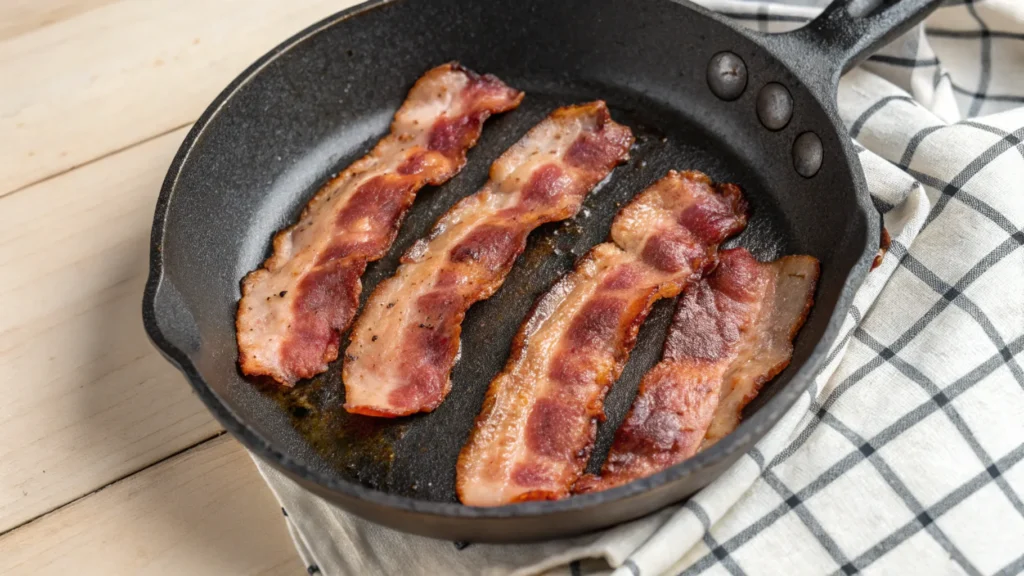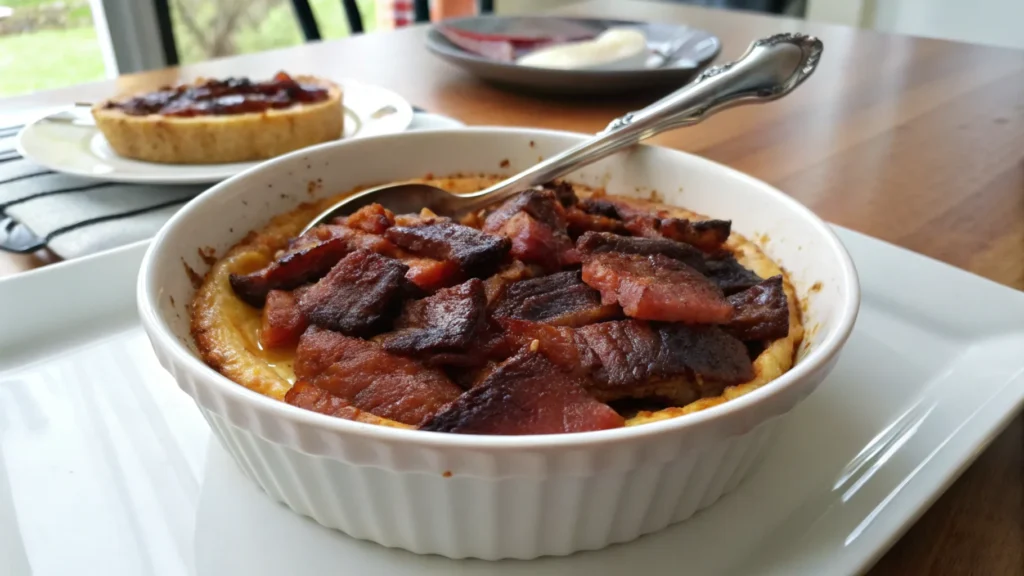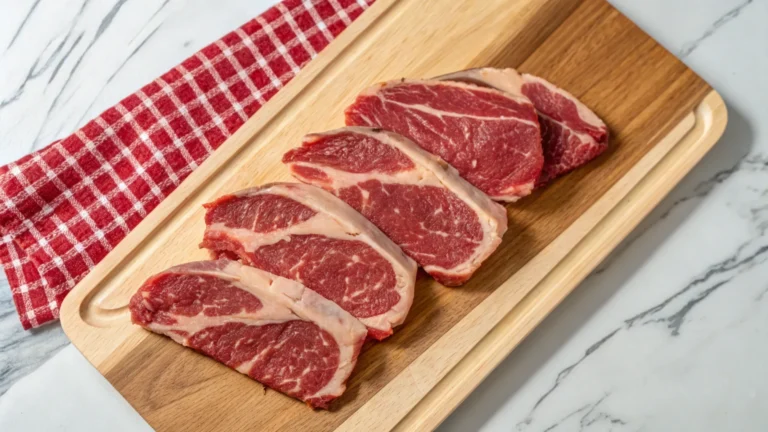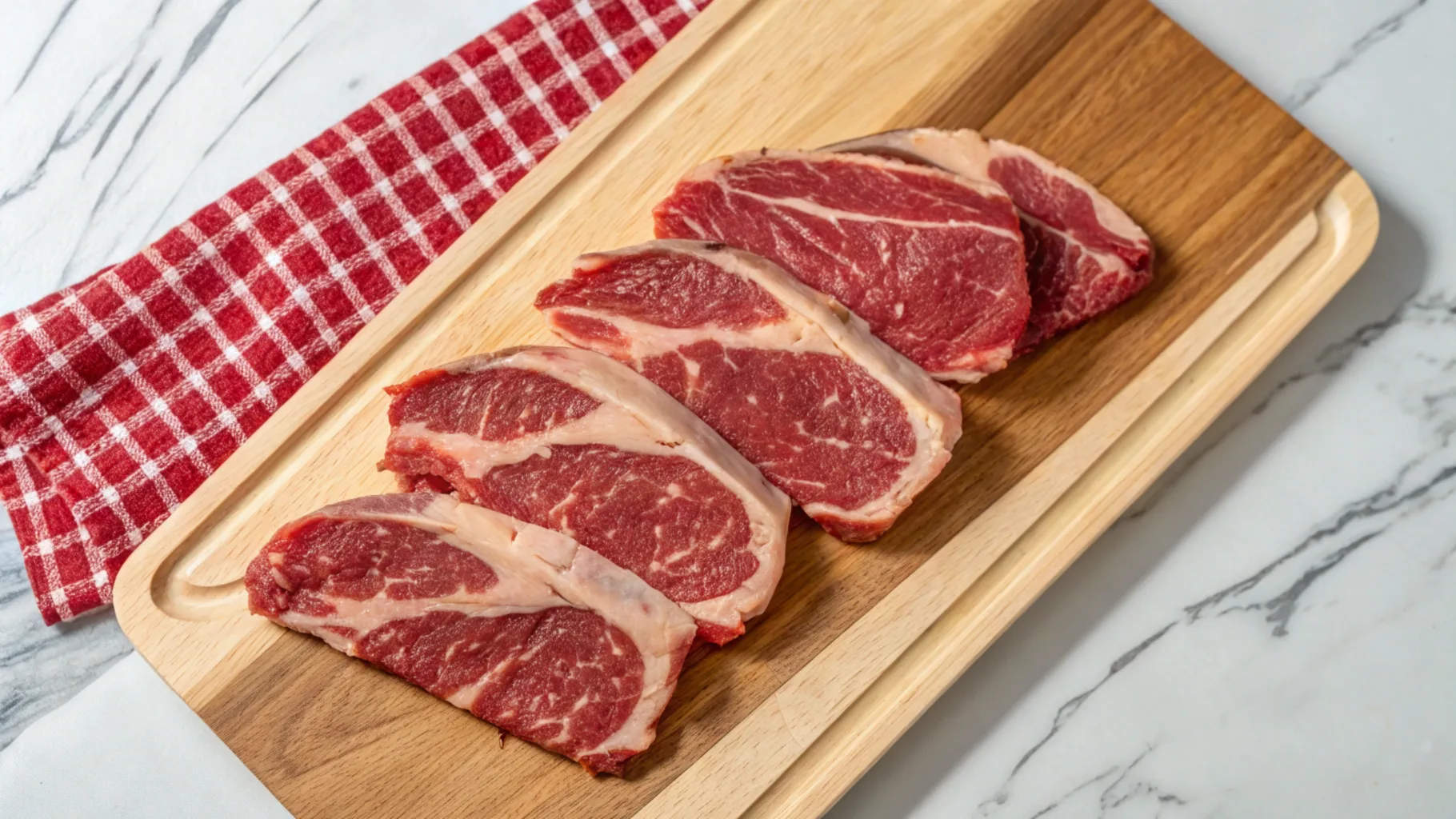Ah, bacon—the universal favorite, right? But what if I told you there’s a pork-free option that doesn’t skimp on flavor? That’s right, beef bacon is here to shake things up! Whether you’re avoiding pork for dietary reasons or just craving something new, beef bacon is a tasty alternative that’s gaining serious momentum.
In this article, we’ll break down everything you need to know about beef bacon, from how it’s made to its nutritional perks. Plus, we’ll toss in some recipes and shopping tips to help you get your hands on this savory treat. Ready? Let’s dive in.
Table of contents
Introduction to Beef Bacon
What is Beef Bacon?
Okay, let’s clear this up: beef bacon isn’t some gimmick. It’s exactly what it sounds like—bacon made from beef! Specifically, it comes from the beef belly or navel, which is marbled with fat and perfect for curing and smoking. Unlike the pork version, beef bacon has a slightly richer, meatier flavor. It’s got that smoky, salty goodness you love, but with its own unique twist.
And let’s be honest, for those who don’t eat pork—be it for religious, dietary, or personal reasons—beef bacon is a total game-changer.
Why Beef Bacon Matters in the Culinary World
You might be wondering, “Why switch from pork bacon?” Well, here’s the deal: beef bacon isn’t just a replacement—it’s a whole new experience. It’s perfect for folks who keep kosher or halal, but even pork lovers are catching on.
With its bold flavor and versatility, beef bacon works in everything from breakfast staples (hello, bacon and eggs!) to gourmet dishes like salads and pasta. Plus, it’s a great way to try something new and surprise your taste buds.
The Making of Beef Bacon
The Beef Belly: The Key Ingredient
Ever heard of beef belly? That’s where the magic starts. Just like pork bacon comes from a pig’s belly, beef bacon is crafted from the fatty, flavorful navel of a cow. This cut is naturally marbled with fat, which is what gives bacon its signature sizzle and melt-in-your-mouth goodness.
Unlike pork belly, beef belly has a richer, heartier texture. It’s ideal for curing and smoking because the fat content ensures every bite is juicy and flavorful. And, fun fact: the marbling in beef bacon means it’s a great candidate for different curing techniques, giving it a one-of-a-kind taste.
Curing and Smoking Process
Here’s where things get interesting—curing and smoking. First, the beef belly gets a generous rub-down with a mix of curing salts, sugar, and spices. This step locks in flavor and helps preserve the meat. Ever wonder why bacon lasts so long? Yep, it’s all thanks to curing.
Next comes the smoking process. The beef belly is slow-smoked over hardwood, like hickory or applewood, infusing it with a deep, smoky flavor. This step takes hours, but trust me, it’s worth the wait. The result? Beef bacon that’s smoky, savory, and downright irresistible.
Dry-Aging and Flavor Development
Some beef bacon producers take it a step further by dry-aging the meat before curing. What does that do, you ask? Dry-aging intensifies the beefy flavor and makes the texture even more tender. Imagine biting into a strip of bacon that’s smoky, savory, and just a little nutty from the aging process. It’s like a flavor explosion in your mouth.
Dry-aging isn’t always part of the process, but when it is, it creates a premium product that bacon fans can’t get enough of.
Nutritional Comparison: Beef Bacon vs. Pork Bacon
Nutritional Profiles Compared
Is it healthier than pork bacon? Well, it depends on what you’re after. This alternative usually has fewer calories and less fat but doesn’t skimp on protein. A single slice averages 30–40 calories with 2–3 grams of fat, while the pork version can easily double those numbers.
However, don’t let the numbers fool you—bacon is still bacon! Both varieties are high in sodium, which means moderation is key to enjoying it without overloading on salt. On the bright side, if you’re following a high-protein diet like keto, beef bacon can be a great fit, offering the savory satisfaction of bacon with a leaner nutritional profile.
Health Considerations

Here’s where beef bacon really shines: it’s free of pork, making it a safer option for those with sensitivities or dietary restrictions. For those following specific diets, it’s a must-have substitute, offering the same smoky, salty goodness.
Many brands use pasture-raised beef, which often results in leaner meat rich in omega-3 fatty acids. These healthy fats can enhance your diet, balancing flavor and nutrition.
Of course, it’s always worth checking the label. Some brands may use more salt or preservatives during curing, so opting for minimally processed options is a smart move. On the flip side, because it’s so flavorful, you might find yourself using less in recipes, which can help cut down on fat and sodium intake. That’s a win-win!
Cooking with Beef Bacon
Popular Recipes Featuring Beef Bacon
Cooking with beef bacon is a breeze, and the results? Always mouthwatering. You can use it just like pork bacon, but it brings a richer, meatier flavor to the table. Try it in classic breakfast dishes like bacon and eggs, or level up your BLT with its savory twist.
For something special, try using beef bacon as a topping for roasted Brussels sprouts or in gourmet salads. Its bold, smoky flavor pairs perfectly with caramelized veggies. Want an easy appetizer? Wrap it around asparagus or dates, bake until crispy, and watch these treats disappear in no time.
Want something hearty? Try adding crumbled bacon to creamy soups, mac and cheese, or loaded baked potatoes. Its robust flavor makes even the simplest dishes feel gourmet.
For more recipe inspiration, check out the beef back ribs recipe on Eminent Recipes. It’s an excellent pairing for a hearty beef bacon meal or a family feast.
Tips for Cooking Beef Bacon Perfectly
Cooking isn’t rocket science, but there are a few tricks to nail beef bacon every time. Start with a cold skillet—this helps render the fat evenly. Use medium heat to avoid overcooking, and flip the strips halfway for an even crisp.
Prefer hands-free cooking? Bake your beef bacon at 400°F on a foil-lined sheet for about 15 minutes. Want extra crispy edges? Broil for the last couple of minutes, but keep an eye on it—it cooks fast! Don’t forget to save the drippings for frying eggs or roasting veggies—they’re pure flavor gold.
Tips for Cooking Beef Bacon Perfectly
Let’s talk technique. Because beef bacon is leaner than pork, it cooks a little differently. First off, don’t crank up the heat—medium is your best friend. Start with a cold pan, lay the strips flat, and let them slowly render their fat.
If you like it crispy, cook it a tad longer, but keep an eye on it—nobody loves burnt bacon. You can also bake it in the oven at 400°F for even cooking. Oh, and here’s a tip: save the drippings! They’re liquid gold for frying eggs or sautéing veggies.
The Market and Availability of Beef Bacon
Where to Buy Beef Bacon
Finding this savory option isn’t as tricky as you’d think. Many specialty stores and online retailers now carry it, catering to the growing demand. Brands like Mason Hills Farm and Gwaltney are popular for their high-quality offerings, often made from pasture-raised beef. If you’re lucky, grocery chains like Kroger may have it in their meat sections.
For those who prefer shopping online, Amazon offers a range of smoked, cured, and uncured options. If you’re into the farm-to-table vibe, check out farmers’ markets or local butcher shops. Even if they don’t have pre-packaged options, you can ask for beef belly cuts and prepare it yourself at home.
Growing Demand and Trends
In recent years, beef bacon has become increasingly popular. Why? It’s an excellent choice for those avoiding pork, offering them a chance to savor the bacon experience. But it’s not just about dietary needs—many bacon enthusiasts are drawn to its bold, meaty flavor and can’t get enough.
The versatility of beef bacon makes it a favorite in kitchens nationwide. It’s ideal for traditional dishes and shines in creative recipes like salads or garnishes. As more people explore alternative proteins, its popularity continues to grow.
For beef lovers seeking another creative recipe, check out the ground beef bulgogi recipe at Eminent Recipes. It’s another excellent way to explore the rich flavors beef can offer.For more beefy ideas, you might enjoy this ground beef bulgogi recipe for another take on transforming beef into something spectacular.
FAQs:
Best Ground Beef Bulgogi Recipe
Looking for a foolproof bulgogi recipe? Combine ground beef, soy sauce, sesame oil, sugar, and garlic. Pair with rice and veggies for a quick, flavorful meal.
Bulgogi Sauce Recipe
Want a killer bulgogi sauce? Mix soy sauce, brown sugar, sesame oil, garlic, and ginger. Add gochujang for a spicy kick. Perfect for marinating beef or veggies.
Simple Ground Beef Bulgogi Recipe
For an easy bulgogi, brown ground beef and add soy sauce, garlic, sugar, and sesame oil. Simmer until the flavors meld. Serve with steamed rice—quick and delicious!
Bulgogi Ground Beef with Gochujang
Love spice? Add gochujang to your bulgogi recipe. Mix it into the sauce for a fiery twist. Pair with kimchi for an authentic Korean-inspired meal.

Conclusion:
So, there you have it—this isn’t just another bacon alternative; it’s a standout all on its own. From its smoky, savory flavor to its versatility in recipes, this option has something for everyone. Whether you’re frying up a hearty breakfast, adding a bold twist to a salad, or wrapping it around veggies for an easy appetizer, it takes the flavor game to a whole new level.
It’s also perfect for folks who follow kosher, halal, or pork-free diets, not to mention anyone just looking for something different. With more brands and stores offering it, trying beef bacon has never been easier—or tastier.
So why not give it a shot? Who knows—it might just become your new favorite bacon. And hey, if you’re feeling inspired, check out some of the recipes and tips mentioned earlier to start your beef bacon adventure today!
Print
Beef Bacon
Beef bacon is a flavorful and crispy alternative to pork bacon. Marinated to perfection and cooked until golden, it’s a versatile addition to any meal.
- Total Time: 2 hours 10 mins
Ingredients
- 1 lb beef belly or brisket, sliced thinly
- 1/4 cup soy sauce
- 2 tbsp brown sugar
- 1 tbsp smoked paprika
- 1 tsp garlic powder
- 1 tsp onion powder
- 1/2 tsp black pepper
- 1 tbsp olive oil
Instructions
- Prepare Marinade: In a small bowl, combine soy sauce, brown sugar, smoked paprika, garlic powder, onion powder, and black pepper. Stir until well mixed.
- Marinate Beef: Place beef slices in a shallow dish or resealable bag. Pour marinade over the beef, ensuring all slices are coated. Marinate in the refrigerator for at least 2 hours or overnight for better flavor.
- Preheat Oven or Skillet:
- Oven Method: Preheat to 375°F (190°C).
- Skillet Method: Heat olive oil in a large skillet over medium heat.
- Cook Beef Bacon:
- Oven: Arrange beef slices on a baking sheet lined with parchment paper. Bake for 12-15 minutes, flipping halfway through, until crispy.
- Skillet: Cook beef slices in batches for 2-3 minutes per side, or until crisp.
- Serve: Enjoy hot as a breakfast side, in sandwiches, or as a topping for salads and burgers.
Notes
- Cuts of Beef: Use beef belly for a fattier, more tender texture, or brisket for a leaner option.
- Smoky Boost: Add a few drops of liquid smoke to the marinade for an extra smoky flavor.
- Crispier Texture: For extra crispiness, broil for an additional 2 minutes after cooking.
- Storage: Store cooked beef bacon in an airtight container in the refrigerator for up to 4 days. Reheat in a skillet or oven to restore crispness.
- Serving Suggestions: Pair with eggs, avocado toast, or crumble over a baked potato or salad for added flavor.
- Prep Time: 10 mins
- Cook Time: 2 hours

